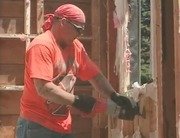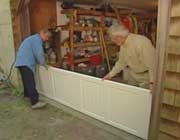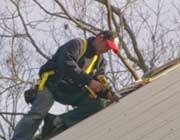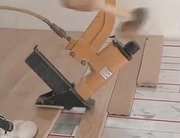Hi, I'm Bob Vila.
Welcome to the show.
Our in-law suite addition has got a nice Galvalume roof that's been installed and also some photovoltaic panels we'll be looking at.
We've also installed Pella's and [??]
fiberglass windows and sash and patio doors.
We're going to look at that.
Inside we're dehumidifying the work space with a giant machine that rolls up to the work site.
And on the outside we're putting up some Azek trim.
Stick around.
It's good to have you with us.
This is our fourth visit to our in-law suite, our addition onto this little colonial here in Norwell, Mass. and we've gotten very familiar with the whole whole process of ICF insulated concrete forms and how that creates the shell of the house.
Basically, using foam building blocks that are filled with rebar and concrete to form the frost wall, the walls and even the first floor deck.
Next, we saw how Howard and his crew framed the second floor deck, the wall that supports the ridge and the roof.
The roof deck was sheathed with GP's Plytanium ply wood.
We're using the deck armor material as our underlayment over the deck.
We ended up putting the roof on in very cold weather, and we were concerned about adhesion between the storm guard which is the peel and stick, vapor impermeable material and so we're using this because the deck is going to be nice and clean and worried about frost, this eliminates the possibilities of frost.
OK, this is a storm guard product.
You can see what they are doing is putting the first piece on and he's going to peel the very top half off and leave the bottom half with the plastic covering on it, so that he can work from the top down.
So, he's basically sticking the the storm guard directly on the deck armor underlayment.
And then he's gonna nail the storm guard as he goes as well.
Next our homeowner Howard, found a source for metal roofing at MetalRoofingW holesalers.com and we have got a professional to come here and show us how it is installed.
This is made out of Galvalume and what that is, that's a steel with an aluminum mix, and you can get it just with steel but the Galvalume, it does a lot more for you as far as rust factor goes.
Especially at the ends of the roof line when you cut your panels, or they're pre-cut, then you're going to have exposed metal on the edge.
And what that does, is it prevents it from rusting as much as like a normal steel panel would.
They do sell them in steel panels and you can get 'em that way but I recommend getting gavel loom, 'cause that's the best for it.
Now this type of panel here, this is a 5V crimp.
And you can get in 29 gauge, 26 gauge .
You can get it cut to length you can get any size you want up to forty feet, and it's a special order for anything you do, but they cut it right then and they ship it in a week.
So you can get whatever you want to fit whatever job you have.
OK.
Well, what we do is we use an outside closure and it goes on the panel like this.
And then after that your ridge cap will go on top of your closure.
And at the screw line, which is here, you put a what they call a self tapping metal screw on all your ribs, and this will prevent any rain or moisture going up into the roof cap.
And you've gotta be careful installing these Galvalume panels 'cause they're big, they can bend, and they can get scratched, but anyway the other panels that we have on the roof are photovoltaics, and Jeff Wolf is with us to explain how photovoltaics work.
It's solar energy, right?
Right, it's solar energy, Bob.
It's solar electricity.
And the way that the panels work is very easy.
The sun rays come down, the photons hit the panels.
The photons make electricity flow through the panels, that direct current solar power comes down through a wire into the house into an inverter.
So that's what you have in the basement.
The other component.
Right, right.
So in the basement, we had that inverter which converts the direct current solar power into alternating current, AC power, that's used in every house in the United States.
Right.
That power is fed into the main electrical panel and feeds the house with solar power, and also when the house is not using so much energy, sunny day, feeds power back into the utility grid and spins the meter back which is making a credit for the customer.
That's the amazing part because all of a sudden you're in the business of generating electricity and selling it back to the utility.
That's right.
That's what people really love, is seeing the meter spin backwards.
Now, people always used to talk about paybacks with any kind of energy related materials.
And, I think it's a little bit less relevant nowadays than it is green.
The big buzzword is green, and we are doing is essentially conserving energy right?
Well, we're conserving energy.
It's green, it's clean, it's reliable, it's U.S. made, invites independence.
Every dollar we spent for electricity and solar power replaces a dollar we send overseas.
So that money stays here.
That clean, green, reliable is what people are really buying today.
And different states are helping people buy that.
In Massachusetts the Renewable Energy Trust actually subsidizes and helps buy down the solar power.
Making it more affordable for people.
Most states have a program like that Yeah, and it is an important thing.
Especially in places where the utility rates, the electricity rates have gone up, by as much as 80 percent.
Right, in many areas of the country we're seeing utility rates escalate and we'll be seeing more of that in the near future.
GroSolar operates throughout the country at www.grosolar.com .
People can find us and find how to work with us anywhere in the country.
We have deals and partners to put solar energy like this on their house anywhere in the US.
Now you were saying this is close to a $15,000 investment, though, and I think the point that needs to be made is that when you are doing a major rehab, and refinancing the equity in your house, etcetera, it's something worth considering as part of it...
Absolutely worth considering as part of that rehab.
Even without a rehab.
With the state programs buying down, that $15,000 investment can become as little as half of that.
Very interesting.
And very affordable for the average homeowner.
Thanks, Jeff.
You're welcome, Bob.
Thank you.






